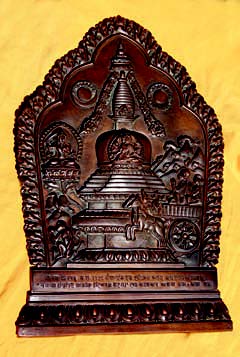Bura/Buri Jamko
The life cycle ritual for elder men and/or women are among the most complicated in the rich Newar ritual tradition, lasting for two or three days. One focus is a maṇḍala that is the object of many offerings. There are also many actions that suggest the new, divine status of the elder.
Most prominent is the construction of a small vehicle especially decorated for the occasion: it has four guardian deities placed at the corners, its forward opening flanked by two small flying horses; its roof has colorful paintings of the aṣṭamaṅgala, the eight auspicious things, fixed above the seat. Once the elder has been seated in the vehicle, all family members bow with their heads touching the elder’s feet. Once ropes are attached to the vehicle, a procession forms with the senior male holding the stupa-plaque, while behind him the elder’s children and grandchildren pull the ropes which move the ratha. As the procession moves ahead, the mood is festive, as the procession moves around the neighborhood and ideally around the town boundary.
The major ritual goal of Burā Jaṃko is to transform the existential status of the elder(s) so that they occupy a higher plane of human existence, one that approaches, or anticipates, his or her divine status after death.
The rituals of jaṃko produce many blessings: protection from the sun, moon, planetary gods (navagraha), as well as the Pañcarakṣā goddesses; assistance from celestial bodhisattvas who extend compassionate blessings; and great quantities of puṇya from making a stūpa, either inscribed on plaque or painting that is ritually-empowered, and then offering donations to a variety of religious leaders, including a brahmin, but primarily gifts to the vajrācāryas conducting the rituals.
As one prominent vajrācārya has summarized the benefits of this tradition: “The common objectives are adding to the life span of the elder, honoring senior citizens, publicly emphasizing to younger family members the religious duty of taking care of senior citizens; the Buddhist activities greatly beneficial to all the family and participants: doing Dharma, earning puṇya, establishing new Buddhist images. The hospitality, gift giving and feasting promotes social connections and serves to distribute wealth.”
WATCH THE VIDEO



